|
|
|
Sort Order |
|
|
|
Items / Page
|
|
|
|
|
|
|
| Srl | Item |
| 1 |
ID:
124700
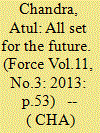

|
|
|
|
|
| Publication |
2013.
|
| Summary/Abstract |
The EADS Innovation Works site at Bangalore exists to prepare the future and explore the synergies for the group and is working on several important projects at present. Interacting with select media in Bangalore on his first visit to India after taking charge as Head of EADS Innovation Works in June this year, Sébastien Remy outlined his plans for the Bangalore centre, "We are focussing on the long term activities like the emerging technologies and solutions". He adds that the Bangalore centre is "working with Cassidian India to optimise performance of radars something that could be fully applicable to existing products. This on-going research work has resulted in the filing of a patent."
|
|
|
|
|
|
|
|
|
|
|
|
|
|
|
|
| 2 |
ID:
129393


|
|
|
|
|
| Publication |
2012.
|
| Summary/Abstract |
That big LCD panel on the wall of your home is an amazing but extravagant piece of technology! And you've obviously spent a fortune on this 'beauty-on-the-wall' to watch things big size! For instance your favorite movies, cricket and other media content stored in your iPod, product IDD of pen drives.
|
|
|
|
|
|
|
|
|
|
|
|
|
|
|
|
| 3 |
ID:
125764
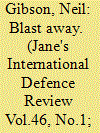

|
|
|
|
|
| Publication |
2013.
|
| Summary/Abstract |
The recent asymmetric conflicts in Afghanistan and Iraq have shown that buried improvised explosive devices (IEDs) are a preferred method to attack the numerically and technically superior allied armoured forces.
|
|
|
|
|
|
|
|
|
|
|
|
|
|
|
|
| 4 |
ID:
142579
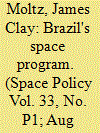

|
|
|
|
|
| Summary/Abstract |
Brazil's space program represents an anomaly among those of the world's 10 largest economic powers. During a time that has witnessed the rapid emergence of a variety of national space programs—even among lesser powers like Iran and South Korea–Brazil's failure to emerge as a significant space actor requires further analysis. This article traces the history of Brazil's space efforts and examines the factors that have held it back, some of which continue to influence its policies today: inadequate funding, conflicting organizations, poorly handled foreign relations, and an unclear national vision for Brazil's “place” in space. Recent efforts to overcome these hurdles through an improved domestic strategy and smarter international relations show promise. But a more sustained political commitment to space development will be needed if they are to succeed.
|
|
|
|
|
|
|
|
|
|
|
|
|
|
|
|
| 5 |
ID:
045377


|
|
|
|
|
| Edition |
workshop Proceedings
|
| Publication |
New Delhi, National Institute of Science, Technology and Development Studies, 1983.
|
| Description |
424p.
|
|
|
|
|
|
|
|
|
|
|
|
Copies: C:1/I:0,R:0,Q:0
Circulation
| Accession# | Call# | Current Location | Status | Policy | Location |
| 025153 | 338.927/NAT 025153 | Main | On Shelf | General | |
|
|
|
|
| 6 |
ID:
189998
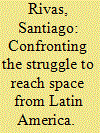

|
|
|
| 7 |
ID:
131714


|
|
|
|
|
| Publication |
2014.
|
| Summary/Abstract |
Mindful of increased reliance on undersea data networks, the US defence advanced research projects agency (DAPRA) has begun a programme to develop a demonstrate novel technologies that can temporally restore network connectivity in contested environments.
|
|
|
|
|
|
|
|
|
|
|
|
|
|
|
|
| 8 |
ID:
129243
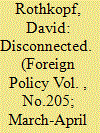

|
|
|
|
|
| Publication |
2014.
|
| Summary/Abstract |
The fabric of civilization is being rewoven around us. The very nature of life, work, and society is changing so profoundly that we are approaching a moment at which our old ways of thinking about the structures that sustain us may be seen as obsolete. This happens periodically throughout history -- think of the Renaissance, the Reformation, the Enlightenment, and the Industrial Revolution. Such eras often produce turmoil or upheaval, until leaders emerge who are able to help shape a new order for a new age.
The question today is whether our leaders are up to the challenge. Given their lack of grounding in the world's most pressing scientific and technological issues, I fear many, if not most, are not. Formerly disenfranchised populations are increasingly connecting to telecom, Internet, and other services. For instance, mobile-phone penetration was estimated to have surpassed 80 percent in Africa in the first quarter of 2013, according to figures published in 2012 by ABI Research. What's more, it is growing faster in Africa than anywhere else in the world. And though smartphone penetration in Africa is just 20 percent -- pretty near global levels -- it is expected to explode in the next few years.
|
|
|
|
|
|
|
|
|
|
|
|
|
|
|
|
| 9 |
ID:
132984
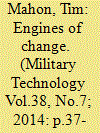

|
|
|
|
|
| Publication |
2014.
|
| Summary/Abstract |
The by-pass jet turbine engine concept did not just arrive onto the aero-engine scene in the early 1960s, it made a quantum leap forward from the perspectives of 1) performance 2), efficiency and 3) technology. Development since then significantly improved these three areas and considerably increased 'dual use' uptake, in which both military and civil markets benefit from the underlying technological advances being made across the entire aerospace industry.
|
|
|
|
|
|
|
|
|
|
|
|
|
|
|
|
| 10 |
ID:
130055
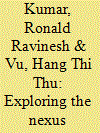

|
|
|
|
|
| Publication |
2014.
|
| Summary/Abstract |
In this article, we explore the nexus between information and communications technology (ICT), remittances and output per worker in Vietnam from 1980 to 2012. Within the augmented Solow framework, we deploy the autoregressive distributed lag bounds procedure and Granger causality tests to examine the short-run and long-run effects and the direction of causality, respectively. The results show that ICT has a momentous short-run (0.002 per cent) and long-run (0.006 per cent) effect on per worker output. However, in the long run, the elasticity coefficient of remittances is positive but not significant within the 1-10 per cent level of significance, and the short-run results show mixed effects. The causality result indicates bidirectional causation between remittances and output per worker, duly emphasizing their mutually reinforcing effect and a unidirectional causation from capital per worker and ICT to remittances, respectively.
|
|
|
|
|
|
|
|
|
|
|
|
|
|
|
|
| 11 |
ID:
074388
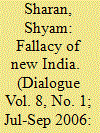

|
|
|
| 12 |
ID:
098175


|
|
|
| 13 |
ID:
129232
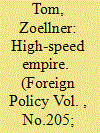

|
|
|
|
|
| Publication |
2014.
|
| Summary/Abstract |
Chinese rail is sprawling, modern, and elegant. It's also convoluted, corroding, and financially alarming. Wanna take a ride? THE BULLET TRAIN hurtles toward the industrial city of Taiyuan in northern China, and seemingly within seconds, the modern, smog-soaked Beijing skyline gives way to open fields. David Su is munching on pistachios in the bar car, careful that not a crumb hits his blue foulard scarf, as he heads some 320 miles to reach his early-morning appointment for a private equity firm. Over his shoulder, the Chinese countryside is a disembodied blur: farms and factories receding at the mind-aching speed of 186 miles per hour. Cars on a nearby highway seem to be creeping along by comparison. Su travels frequently for his job at Global Capital Investments Group, and he likes this new high-speed train, zipping along on one of several dozen lines built by the Chinese government in a decade-long blitzkrieg program that now has a price tag of $500 billion.
|
|
|
|
|
|
|
|
|
|
|
|
|
|
|
|
| 14 |
ID:
129682
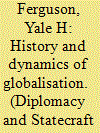

|
|
|
|
|
| Publication |
2014.
|
| Summary/Abstract |
Globalisation involves geographically wider transaction networks and has multiple interrelated dimensions. The globalisation process has geographical scope, volume and density of transactions, and a direction and pace of change. Globalization has a long history, and the local and the global have almost continuously interacted. Most forward changes have been incremental, and there have also been major reversals or almost complete system-breakdowns. There are numerous drivers of globalization of different types, persons, and groups with varying motives, and anonymous drivers like technology, weather, and disease. The article devotes most attention to a review of selected patterns and trends in contemporary globalisation These are climate change; demographic trends, income inequality, and migration; security concerns, technology, and peacekeeping; competing ideologies; the global economy, equities, trade, banking reform, and tax havens; and shifting power relationships among the United States, Europe, China, Japan, and Emerging Markets.
|
|
|
|
|
|
|
|
|
|
|
|
|
|
|
|
| 15 |
ID:
127235


|
|
|
|
|
| Publication |
2014.
|
| Summary/Abstract |
We focus on predicting the adoption time probabilities of photo-voltaic solar panels by households using discrete choice experiments and an innovation diffusion model. The primary objective of this research is cohesively mapping the theory of disruptive innovation into diffusion of innovations to aid policy makers by linking two critical uncertainties of new technology: (1) whether households prefer the new attributes of the new technology and how these preferences vary by market segments? and (2) when are they going to adopt (if at all)? Our study uses recent developments of discrete choice experiments and establishes a causal link between the attributes of the technology, attitudinal constructs and socio-demographics, and adoption time probabilities using the Bass diffusion model. The data was collected from Ontario, a province of Canada. The innovation diffusion model allows us to compute the cumulative probability of adoption over time per household. Technology awareness and energy cost saving have a significant effect on the adoption probability, reinforcing the need for effective education. These findings also suggest that campaigns should explain more about investment criteria, feed-in tariffs and environmental attributes. This study findings call for a need to use seeding strategies to accelerate exogenous Word-of-Mouth (WOM) for this new technology.
|
|
|
|
|
|
|
|
|
|
|
|
|
|
|
|
| 16 |
ID:
127241
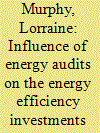

|
|
|
|
|
| Publication |
2014.
|
| Summary/Abstract |
Energy audits are promoted as an effective tool to drive investment in energy efficiency measures in the residential sector. Despite operating in many countries for several decades details of the impact of audits are mixed. The aim of research presented here is to explore the role of audits on investment in energy efficiency measures by private owner-occupied householders in the Netherlands. Results showed that the main influence of the energy audit was to confirm information held by householders. A significant portion of audit recommendations was ignored, the main reason being that householders considered their dwellings to be adequately energy efficient. A comparison of audit recipients to non-recipients showed that audit recipients did not adopt, plan to adopt or invest in more energy efficiency measures than non-recipients. In fact non-recipients adopted more and invested more in measures. It is concluded that energy based renovation is driven by householder perception of comfort and acceptable outlay on energy bills and not necessarily to expert technical tailored information on the potential to reduce CO2 emissions and environmental impact. Results support arguments for minimum energy efficiency standards and performance based incentives.
|
|
|
|
|
|
|
|
|
|
|
|
|
|
|
|
| 17 |
ID:
128429
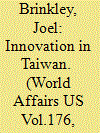

|
|
|
|
|
| Publication |
2014.
|
| Summary/Abstract |
Taiwan's president, Ma Ying-jeou, sat in a low leather chair looking out over the vast presidential conference room of his Taipei office. On the wall behind him hung a portrait of Sun Yat-sen, the Chinese icon who is credited with the revolution a century ago that ended two thousand years of imperial rule. Under Ma's feet lay a light blue carpet festooned with white representations of ocean waves. Overhead, white cloth, styled like ship sails, covered the ceiling lights-all of it intended to represent Taiwan's journey away from mainland China. Asian conference rooms are unlike those in the West. There's no mahogany conference table. Instead, plush chairs are arranged in a U shape. And the conference leader, in this case President Ma, sits at the center with his conferees to his left and right-university professors, think tank leaders, and government officials from Asia and the West who were there for a conference on the East China Sea debate between Taiwan, China, and Japan.
|
|
|
|
|
|
|
|
|
|
|
|
|
|
|
|
| 18 |
ID:
124371
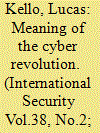

|
|
|
|
|
| Publication |
2013.
|
| Summary/Abstract |
Security policy in the information age faces formidable challenges. Chief among these is to evaluate correctly the impact of cyberweapons on strategy: Does the new technology require
a revolution in how scholars and policymakers think about force and conºict?1 Practitioners confront a predicament in addressing this question: the cyber revolution gives rise to novel threats and opportunities requiring immediate policy responses; yet understanding its nature and its consequences for security is a slow learning process. Interpretation of cyber phenomena involves analysis of a new body of experience that existing theories may be unable to clarify. It presupposes, moreover, a technical understanding of a transforming technology, whose implications require time to master because of its scientific complexity.
|
|
|
|
|
|
|
|
|
|
|
|
|
|
|
|
| 19 |
ID:
130735
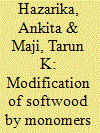

|
|
|
|
|
| Publication |
2014.
|
| Summary/Abstract |
Technological development of wood polymer composites (WPC) is a very promising approach to overcome most of the disadvantageous properties of wood products, for example their poor mechanical strength, poor dimensional stability, susceptibility to fungal attack, weathering and the like. To find the substitute for costly items of hard wood, suitable technologies have been developed to modify softwood to meet specific end-use requirements. Various vinyl monomers and/or copolymers or thermosetting resin in combination with different types of cross linking agents, flame retarding agents have been used to improve the properties of wood. Nanotechnology is a new area of science and technology which opens up new opportunities to develop wood based products with desired properties. Now-a-days government is making strict legislations to promote green technology for the protection of environment world wide. With the depletion of petroleum resources at alarming rate, it is high time to replace petroleum-based products by some sustainable alternative products based on vegetable biomass. The bio-based resins obtained from renewable feedstock have been widely utilized by taking the advantages of easy availability, renewable nature and low cost. The green route of modification of wood is widely encouraged. With the progress of technological development, now it is possible to avoid the hazardous influence of organic solvents by using water as solvent or diluents formodification of wood. WPC has got tremendous scope for use in diverse areas of applications.
|
|
|
|
|
|
|
|
|
|
|
|
|
|
|
|
| 20 |
ID:
124018


|
|
|
|
|
| Publication |
2012.
|
| Summary/Abstract |
Today's tech-dependent, risk-averse submarine culture keeps young officers from developing warfighting skills crucial to success in conflict.
|
|
|
|
|
|
|
|
|
|
|
|
|
|
|
|
|
|
|
|
|